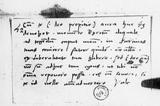Letter #237
Jan ZAMBOCKI to Ioannes DANTISCUSCracow (Kraków), 1525-03-14
Manuscript sources:
Auxiliary sources:
Prints:
| ||||||||||||
Text & apparatus & commentary Plain text Text & commentary Text & apparatus Excerpts concerning Dantiscus' travels
Spectabili et Generoso stain⌈[eneroso]eneroso stain⌉ Domino
cf.
Addidisti,
cf. Gel. 14.4 (title) Quod apte Chrysippus et graphice imaginem Iustitiae modulis coloribusque verborum depinxit ⌊depinxeras omnia, graphice orig. graphicae⌈graphicegraphice orig. graphicae⌉cf. Gel. 14.4 (title) Quod apte Chrysippus et graphice imaginem Iustitiae modulis coloribusque verborum depinxit ⌋
etc. Dispeream, si unius voculae, quam ad te tunc scripseram, recordor. Sed quia abiens sic iusseras, ut videlicet ad te scriptitarem superinscribed⌈ut videlicet ad te scriptitaremut videlicet ad te scriptitarem superinscribed⌉ idemque litteris tuis et
cf.
Cupio te eo ipso, quo cf.
Scias  BCz, 243, p. 40 ferme totam verbum Dei purum et Evangelicam doctrinam, repudiatis patrum (nescio quorum) traditionibus, amplexam et iureiurando obstrictam, verbo Dei et regis Poloniae, domini superinscribed in place of crossed-out o⌈oii superinscribed in place of crossed-out o⌉ sui superinscribed in place of crossed-out o⌈oii superinscribed in place of crossed-out o⌉ (ad extremum usque spiritum) imperio parere, si quis contra ierit, eum capitis damnar stain⌈[ar]ar stain⌉i, novos magistratus quoque deiectis veteribus, creasse superinscribed⌈creassecreasse superinscribed⌉, solo
BCz, 243, p. 40 ferme totam verbum Dei purum et Evangelicam doctrinam, repudiatis patrum (nescio quorum) traditionibus, amplexam et iureiurando obstrictam, verbo Dei et regis Poloniae, domini superinscribed in place of crossed-out o⌈oii superinscribed in place of crossed-out o⌉ sui superinscribed in place of crossed-out o⌈oii superinscribed in place of crossed-out o⌉ (ad extremum usque spiritum) imperio parere, si quis contra ierit, eum capitis damnar stain⌈[ar]ar stain⌉i, novos magistratus quoque deiectis veteribus, creasse superinscribed⌈creassecreasse superinscribed⌉, solo
Fridericus, d(ux) or d(ominus)⌈d(ux)d(ux) or d(ominus)⌉ Lignicensis, et Georgius marchio, sunt hic, sunt et totius Prussiae dynastae praeter Culmensem palatinum. Agitur maximo nisu de concordia inter magistrum et regem. Quibusnam condicionibus ea concordia tentetur, nobis, qui foris pergraecamur, non satis liquet. Ego me usque in hesternum diem domi continui, censentibus medicis, heri vesperi invisi ducem Fridericum, qui mox et de te et de rebus tuis percontatus est. Respondi, ut me decuit. Is mihi visus est parum spei habere, rem ita posse transigi, ut ab ipsis instructa est. Hodie accersiti fuerunt ambo pacificatores ad consilium et mox dimissi, interim consultatur in Gallipede, dum pacificatores prandent, et ego haec scribo hora quasi XX. Atque ita, mi Ioannes, quis eius fabulae exitus futurus est, te certificare non possum, quamquam sciam tibi vehementer gratum fore, si conclusionem scires, sed a me id fieri nequit ms. d(!) ⌈tt ms. d(!) ⌉, non prius enim ista in vulgus efferentur, quoad in consilio transacta fuerint. Veredarius autem iste sive postarius aut hodie et, qui has litteras auferre debet, aut hodie aut cras mane abiturus hinc dicitur, quare cogor iamiam has nugas in fasciculum conicere.
De futuris rebus nostris facile est divinare: imminent Turci et Tartari et praeterita quidem superinscribed⌈quidemquidem superinscribed⌉ aestate cecidimus eos, utcumque nunc qu ms. m(!) ⌈uu ms. m(!) ⌉omodo succedet, Deus scit. Non deesset argumentum non epistulam sed volumen scribendi, sed ob imbecillitatem corporis, quam ex diutina aegritudine contraxi, vix haec exarare potui.
De fratre tuo non dubito, quin tibi d(octor) Bork scribet. Si huc venisset, fecissem, quae iusseras, etiam si episcopus fastidisset, ego eum aluissem, nisi forte sordida rura et humiles habitare casas mecum dedignatus fuisset.
Nudius tertius allatae huc erant marchioni a regina Hungariae litterae superinscribed⌈litteraelitterae superinscribed⌉, in quibus significabatur regem Galliae a caesarianis vivum captum exercitumque eius caesum et fugatum interfectis in acie XIIII milibus, sed nondum plena fides eis habetur. Exspectamus itaque, si quid certioris fama affluxerit.
 BCz, 243, p. 45
Tertius noster [...] stain⌈[...][...] stain⌉ cetera
cf. Hor. Carm. 1. 22. 1 integer vitae scelerisque purus ⌊integer tamen vitaecf. Hor. Carm. 1. 22. 1 integer vitae scelerisque purus ⌋
etc. Ideo ferendus immo [...] stain⌈[...][...] stain⌉ndus de istis, quibus te commendari a me voluisti [...] stain⌈[...][...] stain⌉uid tibi in mentem venerit, neque ego umquam perspiciam [...] stain⌈[...][...] stain⌉ tantopere familiarem extitisse et ipse ab hoc grege [...] stain⌈[...][...] stain⌉ prorsus semper submovebar, subiissem tamen eos ade[...] stain⌈[...][...] stain⌉mendi om{m}nem molestiam et indignitatem (tantum te amo). Si [...] stain⌈[...][...] stain⌉ commendationem meam apud eos aliquod pondus habituram existimassem stain⌈[m]m stain⌉ sed percellebat afflatu quodam me ab eis non magni fieri [...] stain⌈[...][...] stain⌉ et a commendatione supersedi, ne in vacuum currerem. Tu, pro tuo in me amore, non negligentiae meae, quominus id fecerim, adscribes, sed iustis causis, quarum unam iam quidem tenes, reliquas cum te Deus nobis reducere fecerit, intelliges. Si veniens te moribus et laudatissimis institutis eorum accommodaveris vel addixeris, commendatissimus eris etiam nemine te commendante.
BCz, 243, p. 45
Tertius noster [...] stain⌈[...][...] stain⌉ cetera
cf. Hor. Carm. 1. 22. 1 integer vitae scelerisque purus ⌊integer tamen vitaecf. Hor. Carm. 1. 22. 1 integer vitae scelerisque purus ⌋
etc. Ideo ferendus immo [...] stain⌈[...][...] stain⌉ndus de istis, quibus te commendari a me voluisti [...] stain⌈[...][...] stain⌉uid tibi in mentem venerit, neque ego umquam perspiciam [...] stain⌈[...][...] stain⌉ tantopere familiarem extitisse et ipse ab hoc grege [...] stain⌈[...][...] stain⌉ prorsus semper submovebar, subiissem tamen eos ade[...] stain⌈[...][...] stain⌉mendi om{m}nem molestiam et indignitatem (tantum te amo). Si [...] stain⌈[...][...] stain⌉ commendationem meam apud eos aliquod pondus habituram existimassem stain⌈[m]m stain⌉ sed percellebat afflatu quodam me ab eis non magni fieri [...] stain⌈[...][...] stain⌉ et a commendatione supersedi, ne in vacuum currerem. Tu, pro tuo in me amore, non negligentiae meae, quominus id fecerim, adscribes, sed iustis causis, quarum unam iam quidem tenes, reliquas cum te Deus nobis reducere fecerit, intelliges. Si veniens te moribus et laudatissimis institutis eorum accommodaveris vel addixeris, commendatissimus eris etiam nemine te commendante.
Vale felix et, quod dudum fecisti, me ama te non ficte te(!) amantem.
Iterum vale.
Tuus
Postscript:
Cum te (Deo propitio) aura
Vale.




